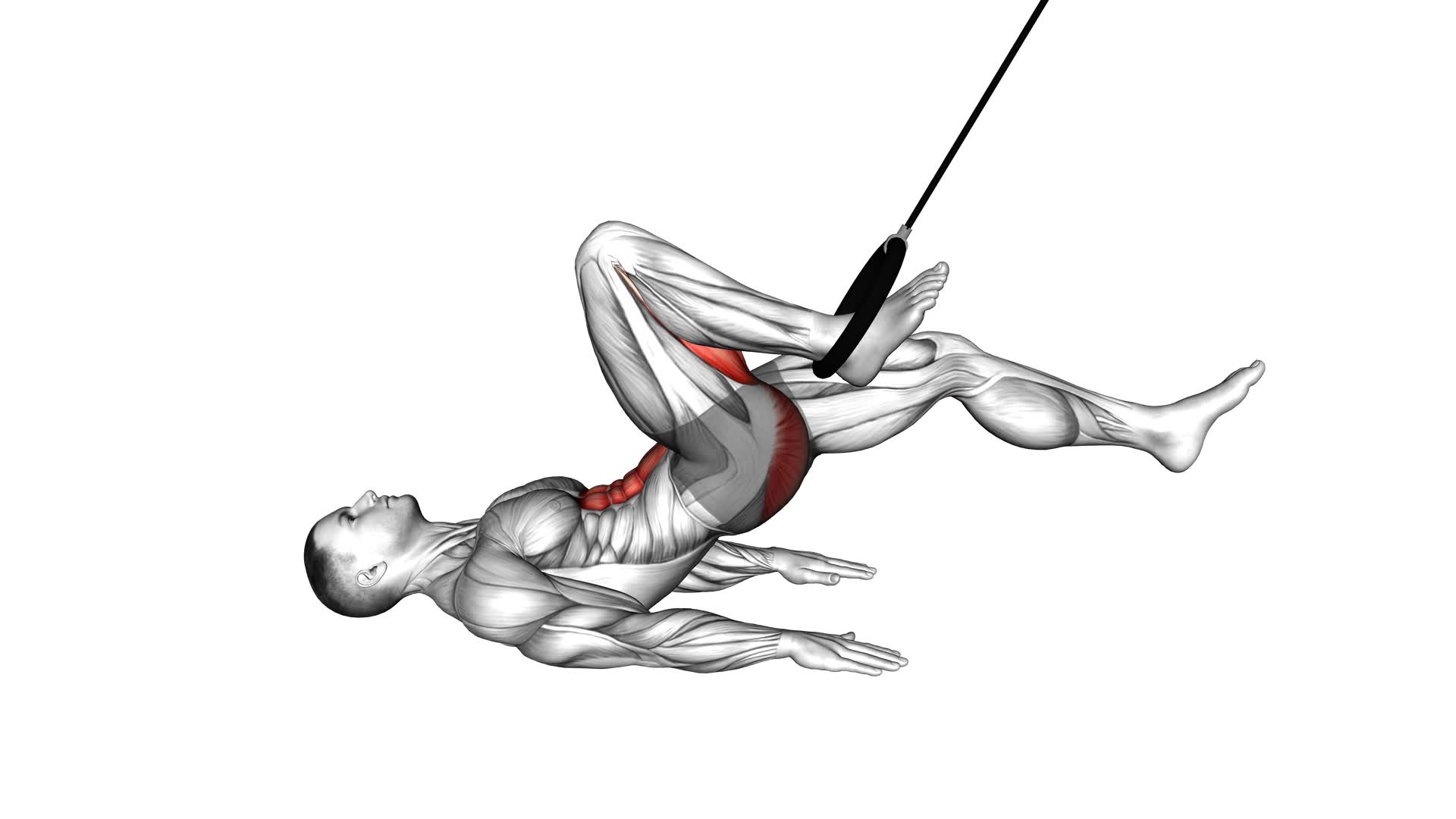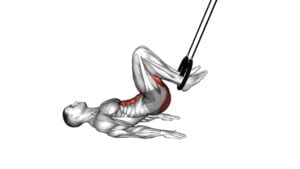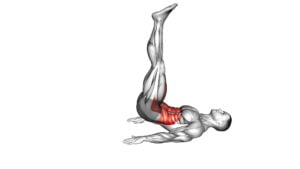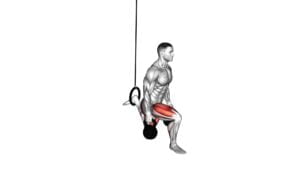Ring Hip Lift Single Leg Curl (male) – Video Exercise Guide & Tips

Are you looking for a challenging leg exercise that targets your glutes and hamstrings? Look no further than the Ring Hip Lift Single Leg Curl.
Watch This Exercise Video
This video exercise guide and tips will show you the proper form and technique to maximize your results.
With variations and modifications to push yourself further, and common mistakes to avoid, you'll be able to incorporate this exercise into your workout routine with confidence.
Get ready to feel the burn and see the results you've been working towards.
Key Takeaways
- Ring Hip Lift Single Leg Curl targets glutes and hamstrings, improving their strength for activities like running and jumping.
- This exercise enhances stability, balance, and engages core muscles, contributing to better overall functional movement.
- Proper form and technique are essential, including attaching the ring to a sturdy anchor point, maintaining body alignment, and avoiding excessive swinging or momentum.
- Gradual progression and increased difficulty, such as adding resistance or performing the exercise on an unstable surface, can lead to better results.
Benefits of the Ring Hip Lift Single Leg Curl
You will experience enhanced hamstring strength and stability with the Ring Hip Lift Single Leg Curl. This exercise specifically targets your hamstrings, which are the muscles located at the back of your thighs. By performing the Ring Hip Lift Single Leg Curl, you can expect to see improved hamstring strength, which is beneficial for activities such as running, jumping, and even everyday movements like walking and climbing stairs.
In addition to improved hamstring strength, this exercise also helps to increase stability and balance. The Ring Hip Lift Single Leg Curl requires you to engage your core muscles and maintain proper body alignment throughout the movement. This helps to improve your overall stability and balance, which is essential for various physical activities and sports.
By incorporating the Ring Hip Lift Single Leg Curl into your workout routine, you can reap the benefits of improved hamstring strength and increased stability and balance. These improvements won't only enhance your athletic performance but also contribute to better overall functional movement.
Now that you understand the benefits of the Ring Hip Lift Single Leg Curl, let's move on to discussing the proper form and technique for this exercise.
Proper Form and Technique for the Exercise
To ensure proper form and technique for the Ring Hip Lift Single Leg Curl, follow these guidelines. This exercise can be challenging, so it's important to start with the correct form to avoid common mistakes and maximize your results.
First, begin by attaching the ring to a sturdy anchor point and adjusting the height to your hip level. Stand facing away from the anchor and place one foot through the ring, securing it around your ankle.
Next, lift your leg off the ground, keeping your body straight and your core engaged. This is your starting position.
To perform the exercise, bend your knee and bring your heel towards your glutes, while keeping your hips lifted and your body straight. Pause for a moment at the top of the movement, squeezing your glutes.
Ensure that you maintain control throughout the exercise, avoiding any swinging or jerking motions. Keep your movements slow and controlled, focusing on engaging your hamstring muscles.
For beginners, it's important to start with a lighter resistance band and gradually increase the difficulty as your strength improves. Additionally, make sure to warm up properly before attempting this exercise to prevent injury.
Variations and Modifications to Challenge Yourself
Are you looking for ways to challenge yourself and take your Ring Hip Lift Single Leg Curl to the next level? If you've mastered the basic form and technique, it's time to explore advanced modifications and progression options. These variations won't only make the exercise more challenging but also help you build strength and improve your overall fitness.
One advanced modification you can try is adding a resistance band to the exercise. Attach the band to the rings and loop it around your working leg. This will provide additional resistance, making the movement more challenging and engaging your muscles even more.
Another option is to perform the exercise on an unstable surface, such as a Bosu ball or a foam pad. This will require more balance and stability, forcing your muscles to work harder to maintain control throughout the movement.
To further challenge yourself, you can increase the range of motion by extending your leg fully and touching your toes to the rings at the top of the movement. This will engage your hamstrings and glutes even more, providing a greater stimulus for muscle growth.
By incorporating these advanced modifications and progression options into your Ring Hip Lift Single Leg Curl routine, you can continue to challenge yourself and see further improvements in strength and stability.
Now that you know how to take your exercise to the next level, let's move on to the next section where we'll discuss common mistakes to avoid when performing the exercise.
Common Mistakes to Avoid When Performing the Exercise
While performing the Ring Hip Lift Single Leg Curl exercise, it's important to avoid common mistakes in order to maximize its effectiveness and prevent injury.
One common mistake to avoid is using improper form. It's essential to maintain proper body alignment throughout the exercise. Make sure to keep your core engaged and your hips lifted off the ground. This will help to target the glutes and hamstrings effectively.
Another mistake to avoid is using excessive momentum. This exercise should be performed in a controlled manner, focusing on the contraction of the muscles. Avoid swinging your leg or using momentum to lift your hips higher.
Additionally, it's important to avoid overarching your lower back. This can put unnecessary strain on your spine and lead to injury. Instead, focus on maintaining a neutral spine position throughout the movement.
By avoiding these common mistakes and maintaining proper form, you can ensure that you're getting the most out of the Ring Hip Lift Single Leg Curl exercise while minimizing the risk of injury.
Now, let's move on to the next section to learn some tips for incorporating this exercise into your workout routine.
Tips for Incorporating the Ring Hip Lift Single Leg Curl Into Your Workout Routine
To incorporate the Ring Hip Lift Single Leg Curl into your workout routine, start by focusing on proper form and engaging your core throughout the exercise. This exercise primarily targets the hamstrings, which are the muscles located on the back of your thighs. Hamstring exercises are important for overall lower body strength and stability. They also help to improve athletic performance and prevent injuries.
When incorporating the Ring Hip Lift Single Leg Curl into your routine, it's important to progress gradually. Start with a weight that challenges you but allows you to maintain proper form. As you become more comfortable with the exercise, you can gradually increase the weight or the number of repetitions.
It's also important to ensure that you're using a controlled and slow movement throughout the exercise. This will help to maximize the benefits and prevent any potential injuries.
Incorporating the Ring Hip Lift Single Leg Curl into your routine can be a great way to strengthen your hamstrings and improve your overall lower body strength. By focusing on proper form, engaging your core, and progressing gradually, you can achieve maximum results from this exercise.
Frequently Asked Questions
How Many Repetitions Should I Do for the Ring Hip Lift Single Leg Curl?
For the ring hip lift single leg curl, the recommended number of repetitions depends on your fitness level and goals. It's generally suggested to start with 8-12 repetitions per set. However, you can adjust the number of repetitions based on your capabilities and how challenging the exercise feels.
Additionally, you can vary the difficulty of the exercise by adjusting the height of the rings or by performing the exercise with both legs at the same time.
Can I Perform the Ring Hip Lift Single Leg Curl if I Have Lower Back Pain?
If you have lower back pain, it's important to prioritize injury prevention. The Ring Hip Lift Single Leg Curl may not be suitable for you in this case.
Instead, consider alternative exercises that can help strengthen your legs without putting excessive strain on your lower back. Some options include glute bridges, hamstring curls using a stability ball, or even simple bodyweight squats.
Always listen to your body and consult a professional if needed.
Is It Necessary to Use a Ring for This Exercise, or Can I Use Other Equipment?
You don't necessarily have to use a ring for the exercise. There are other equipment options available for the ring hip lift single leg curl. Depending on your fitness level, you can modify the exercise to suit your needs.
It's important to choose equipment that provides stability and supports your lower back. Make sure to consult a fitness professional to determine the best equipment and modifications for your specific situation.
Can Beginners Perform the Ring Hip Lift Single Leg Curl, or Is It More Suitable for Advanced Trainees?
Beginners can definitely perform the ring hip lift single leg curl, as it's a challenging exercise that targets the hamstrings and glutes. To modify for beginners, start by using a lower ring height and focusing on proper form and control.
If the exercise is still too difficult, alternatives for hamstring development include exercises like glute bridges, seated hamstring curls, or stability ball leg curls. Remember to start with lighter weights and gradually increase as you gain strength and stability.
How Long Should I Rest Between Sets When Performing the Ring Hip Lift Single Leg Curl?
To get the most out of the ring hip lift single leg curl, it's important to know how long to rest between sets. Resting for about 30-60 seconds allows your muscles to recover without losing the intensity of the exercise.
This rest time helps maintain the effectiveness of the workout and prevents fatigue. Remember, proper form and technique are key to maximizing your results.
Conclusion
The Ring Hip Lift Single Leg Curl is a beneficial exercise that targets the glutes, hamstrings, and core muscles. By properly performing this exercise with the right form and technique, you can effectively strengthen and tone these muscle groups.
There are also variations and modifications available to challenge yourself as you progress. Avoiding common mistakes and incorporating this exercise into your workout routine can help you achieve your fitness goals.

Author
Years ago, the spark of my life’s passion ignited in my mind the moment I stepped into the local gym for the first time. The inaugural bead of perspiration, the initial endeavor, the very first surge of endorphins, and a sense of pride that washed over me post-workout marked the beginning of my deep-seated interest in strength sports, fitness, and sports nutrition. This very curiosity blossomed rapidly into a profound fascination, propelling me to earn a Master’s degree in Physical Education from the Academy of Physical Education in Krakow, followed by a Sports Manager diploma from the Jagiellonian University. My journey of growth led me to gain more specialized qualifications, such as being a certified personal trainer with a focus on sports dietetics, a lifeguard, and an instructor for wellness and corrective gymnastics. Theoretical knowledge paired seamlessly with practical experience, reinforcing my belief that the transformation of individuals under my guidance was also a reflection of my personal growth. This belief holds true even today. Each day, I strive to push the boundaries and explore new realms. These realms gently elevate me to greater heights. The unique combination of passion for my field and the continuous quest for growth fuels my drive to break new ground.







